Pedro P. Vergara
Data driven approach towards more efficient Newton-Raphson power flow calculation for distribution grids
Apr 15, 2025Abstract:Power flow (PF) calculations are fundamental to power system analysis to ensure stable and reliable grid operation. The Newton-Raphson (NR) method is commonly used for PF analysis due to its rapid convergence when initialized properly. However, as power grids operate closer to their capacity limits, ill-conditioned cases and convergence issues pose significant challenges. This work, therefore, addresses these challenges by proposing strategies to improve NR initialization, hence minimizing iterations and avoiding divergence. We explore three approaches: (i) an analytical method that estimates the basin of attraction using mathematical bounds on voltages, (ii) Two data-driven models leveraging supervised learning or physics-informed neural networks (PINNs) to predict optimal initial guesses, and (iii) a reinforcement learning (RL) approach that incrementally adjusts voltages to accelerate convergence. These methods are tested on benchmark systems. This research is particularly relevant for modern power systems, where high penetration of renewables and decentralized generation require robust and scalable PF solutions. In experiments, all three proposed methods demonstrate a strong ability to provide an initial guess for Newton-Raphson method to converge with fewer steps. The findings provide a pathway for more efficient real-time grid operations, which, in turn, support the transition toward smarter and more resilient electricity networks.
Optimizing Electric Vehicles Charging using Large Language Models and Graph Neural Networks
Feb 05, 2025
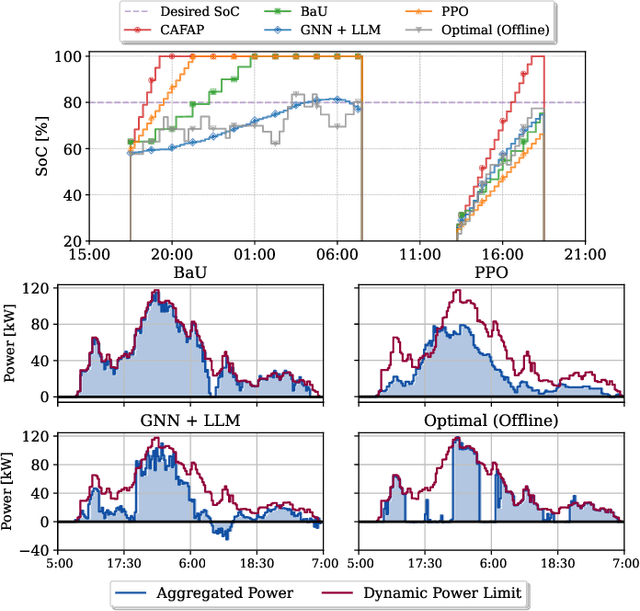


Abstract:Maintaining grid stability amid widespread electric vehicle (EV) adoption is vital for sustainable transportation. Traditional optimization methods and Reinforcement Learning (RL) approaches often struggle with the high dimensionality and dynamic nature of real-time EV charging, leading to sub-optimal solutions. To address these challenges, this study demonstrates that combining Large Language Models (LLMs), for sequence modeling, with Graph Neural Networks (GNNs), for relational information extraction, not only outperforms conventional EV smart charging methods, but also paves the way for entirely new research directions and innovative solutions.
GNN-DT: Graph Neural Network Enhanced Decision Transformer for Efficient Optimization in Dynamic Environments
Feb 03, 2025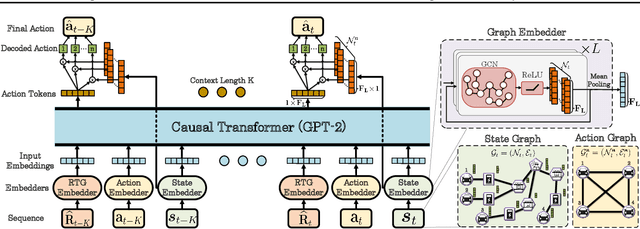
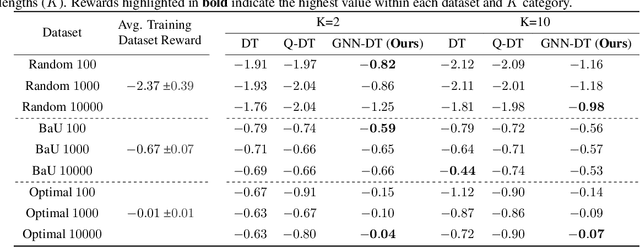
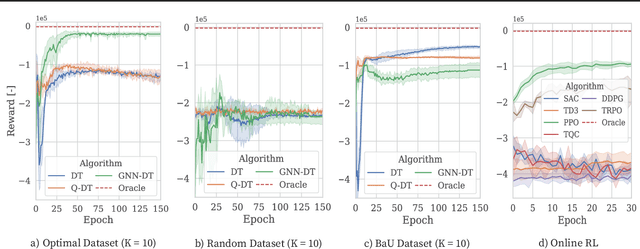

Abstract:Reinforcement Learning (RL) methods used for solving real-world optimization problems often involve dynamic state-action spaces, larger scale, and sparse rewards, leading to significant challenges in convergence, scalability, and efficient exploration of the solution space. This study introduces GNN-DT, a novel Decision Transformer (DT) architecture that integrates Graph Neural Network (GNN) embedders with a novel residual connection between input and output tokens crucial for handling dynamic environments. By learning from previously collected trajectories, GNN-DT reduces dependence on accurate simulators and tackles the sparse rewards limitations of online RL algorithms. We evaluate GNN-DT on the complex electric vehicle (EV) charging optimization problem and prove that its performance is superior and requires significantly fewer training trajectories, thus improving sample efficiency compared to existing DT baselines. Furthermore, GNN-DT exhibits robust generalization to unseen environments and larger action spaces, addressing a critical gap in prior DT-based approaches
Adaptive Informed Deep Neural Networks for Power Flow Analysis
Dec 03, 2024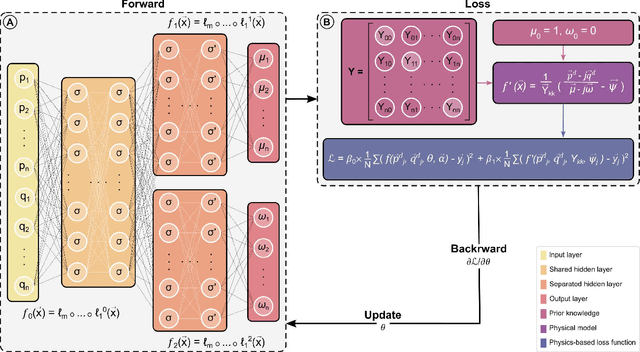
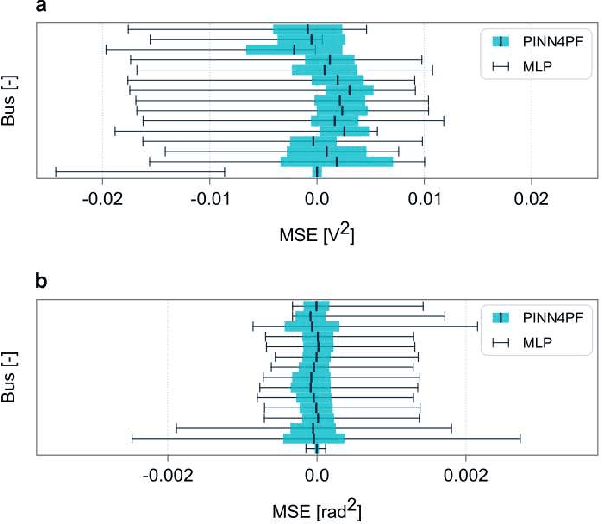
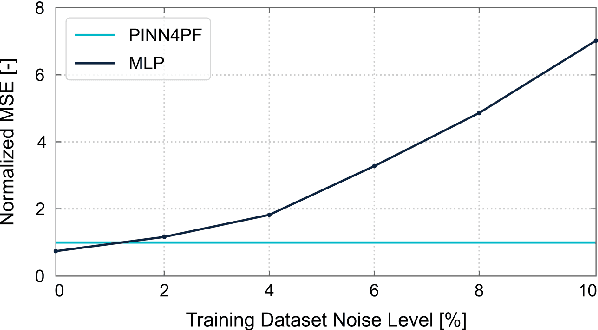
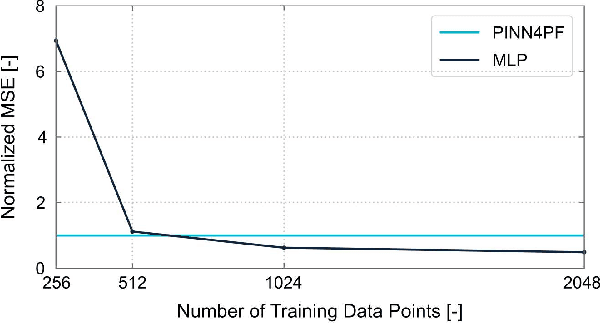
Abstract:This study introduces PINN4PF, an end-to-end deep learning architecture for power flow (PF) analysis that effectively captures the nonlinear dynamics of large-scale modern power systems. The proposed neural network (NN) architecture consists of two important advancements in the training pipeline: (A) a double-head feed-forward NN that aligns with PF analysis, including an activation function that adjusts to active and reactive power consumption patterns, and (B) a physics-based loss function that partially incorporates power system topology information. The effectiveness of the proposed architecture is illustrated through 4-bus, 15-bus, 290-bus, and 2224-bus test systems and is evaluated against two baselines: a linear regression model (LR) and a black-box NN (MLP). The comparison is based on (i) generalization ability, (ii) robustness, (iii) impact of training dataset size on generalization ability, (iv) accuracy in approximating derived PF quantities (specifically line current, line active power, and line reactive power), and (v) scalability. Results demonstrate that PINN4PF outperforms both baselines across all test systems by up to two orders of magnitude not only in terms of direct criteria, e.g., generalization ability but also in terms of approximating derived physical quantities.
An Efficient and Explainable Transformer-Based Few-Shot Learning for Modeling Electricity Consumption Profiles Across Thousands of Domains
Aug 15, 2024
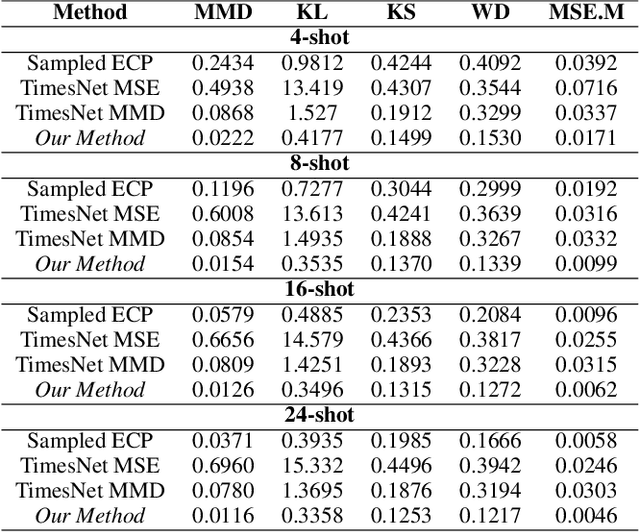
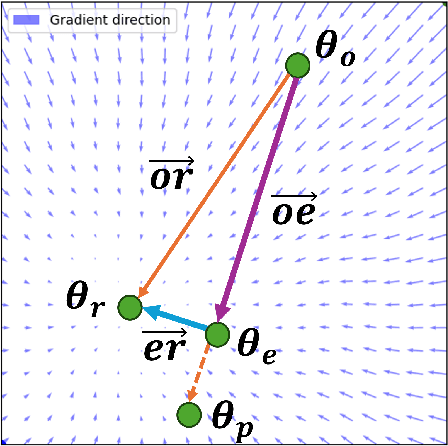
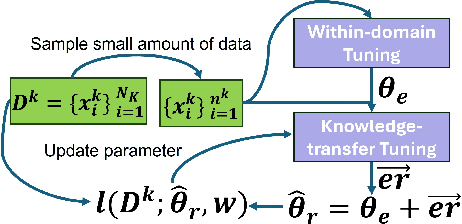
Abstract:Electricity Consumption Profiles (ECPs) are crucial for operating and planning power distribution systems, especially with the increasing numbers of various low-carbon technologies such as solar panels and electric vehicles. Traditional ECP modeling methods typically assume the availability of sufficient ECP data. However, in practice, the accessibility of ECP data is limited due to privacy issues or the absence of metering devices. Few-shot learning (FSL) has emerged as a promising solution for ECP modeling in data-scarce scenarios. Nevertheless, standard FSL methods, such as those used for images, are unsuitable for ECP modeling because (1) these methods usually assume several source domains with sufficient data and several target domains. However, in the context of ECP modeling, there may be thousands of source domains with a moderate amount of data and thousands of target domains. (2) Standard FSL methods usually involve cumbersome knowledge transfer mechanisms, such as pre-training and fine-tuning, whereas ECP modeling requires more lightweight methods. (3) Deep learning models often lack explainability, hindering their application in industry. This paper proposes a novel FSL method that exploits Transformers and Gaussian Mixture Models (GMMs) for ECP modeling to address the above-described issues. Results show that our method can accurately restore the complex ECP distribution with a minimal amount of ECP data (e.g., only 1.6\% of the complete domain dataset) while it outperforms state-of-the-art time series modeling methods, maintaining the advantages of being both lightweight and interpretable. The project is open-sourced at https://github.com/xiaweijie1996/TransformerEM-GMM.git.
RL-ADN: A High-Performance Deep Reinforcement Learning Environment for Optimal Energy Storage Systems Dispatch in Active Distribution Networks
Aug 07, 2024Abstract:Deep Reinforcement Learning (DRL) presents a promising avenue for optimizing Energy Storage Systems (ESSs) dispatch in distribution networks. This paper introduces RL-ADN, an innovative open-source library specifically designed for solving the optimal ESSs dispatch in active distribution networks. RL-ADN offers unparalleled flexibility in modeling distribution networks, and ESSs, accommodating a wide range of research goals. A standout feature of RL-ADN is its data augmentation module, based on Gaussian Mixture Model and Copula (GMC) functions, which elevates the performance ceiling of DRL agents. Additionally, RL-ADN incorporates the Laurent power flow solver, significantly reducing the computational burden of power flow calculations during training without sacrificing accuracy. The effectiveness of RL-ADN is demonstrated using in different sizes of distribution networks, showing marked performance improvements in the adaptability of DRL algorithms for ESS dispatch tasks. This enhancement is particularly beneficial from the increased diversity of training scenarios. Furthermore, RL-ADN achieves a tenfold increase in computational efficiency during training, making it highly suitable for large-scale network applications. The library sets a new benchmark in DRL-based ESSs dispatch in distribution networks and it is poised to advance DRL applications in distribution network operations significantly. RL-ADN is available at: https://github.com/ShengrenHou/RL-ADN.
EnergyDiff: Universal Time-Series Energy Data Generation using Diffusion Models
Jul 18, 2024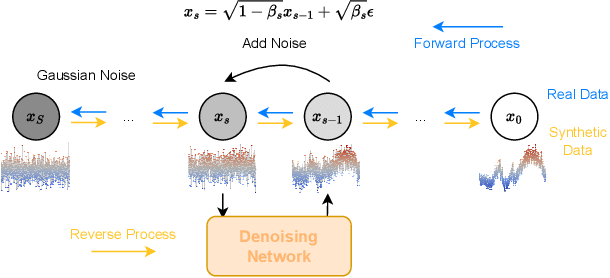
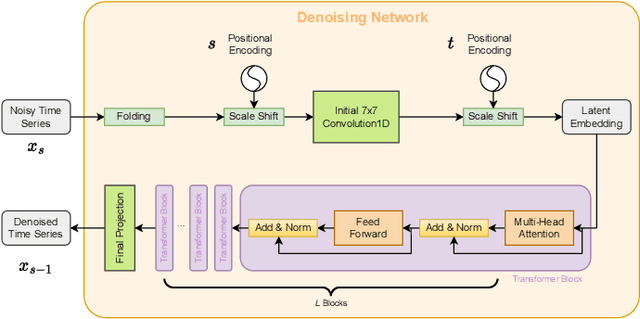
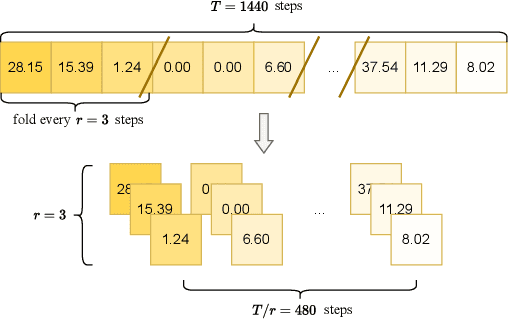

Abstract:High-resolution time series data are crucial for operation and planning in energy systems such as electrical power systems and heating systems. However, due to data collection costs and privacy concerns, such data is often unavailable or insufficient for downstream tasks. Data synthesis is a potential solution for this data scarcity. With the recent development of generative AI, we propose EnergyDiff, a universal data generation framework for energy time series data. EnergyDiff builds on state-of-the-art denoising diffusion probabilistic models, utilizing a proposed denoising network dedicated to high-resolution time series data and introducing a novel Marginal Calibration technique. Our extensive experimental results demonstrate that EnergyDiff achieves significant improvement in capturing temporal dependencies and marginal distributions compared to baselines, particularly at the 1-minute resolution. Additionally, EnergyDiff consistently generates high-quality time series data across diverse energy domains, time resolutions, and at both customer and transformer levels with reduced computational need.
A Flow-Based Model for Conditional and Probabilistic Electricity Consumption Profile Generation and Prediction
May 06, 2024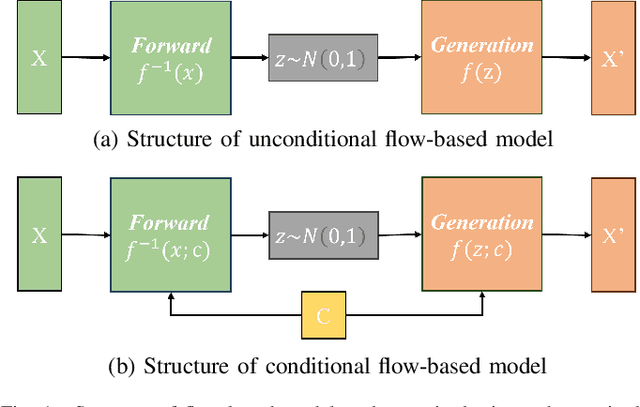
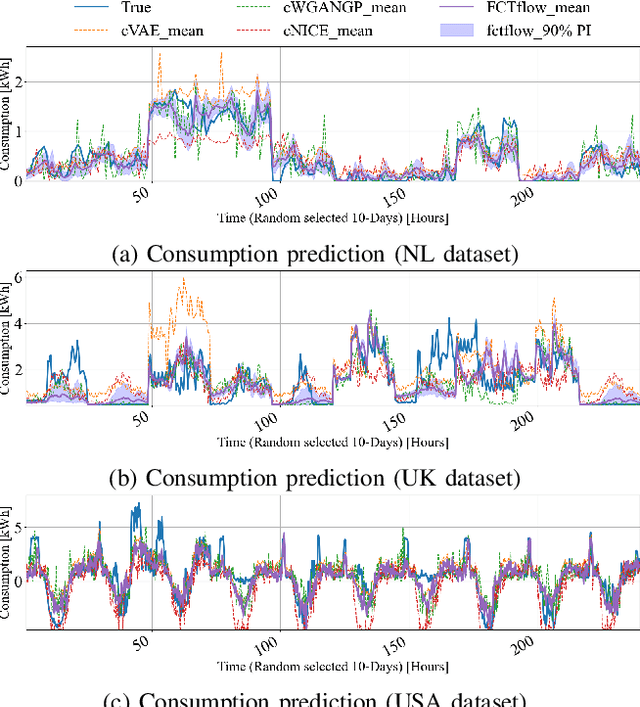


Abstract:Residential Load Profile (RLP) generation and prediction are critical for the operation and planning of distribution networks, particularly as diverse low-carbon technologies are increasingly integrated. This paper introduces a novel flow-based generative model, termed Full Convolutional Profile Flow (FCPFlow), which is uniquely designed for both conditional and unconditional RLP generation, and for probabilistic load forecasting. By introducing two new layers--the invertible linear layer and the invertible normalization layer--the proposed FCPFlow architecture shows three main advantages compared to traditional statistical and contemporary deep generative models: 1) it is well-suited for RLP generation under continuous conditions, such as varying weather and annual electricity consumption, 2) it shows superior scalability in different datasets compared to traditional statistical models, and 3) it also demonstrates better modeling capabilities in capturing the complex correlation of RLPs compared with deep generative models.
EV2Gym: A Flexible V2G Simulator for EV Smart Charging Research and Benchmarking
Apr 02, 2024
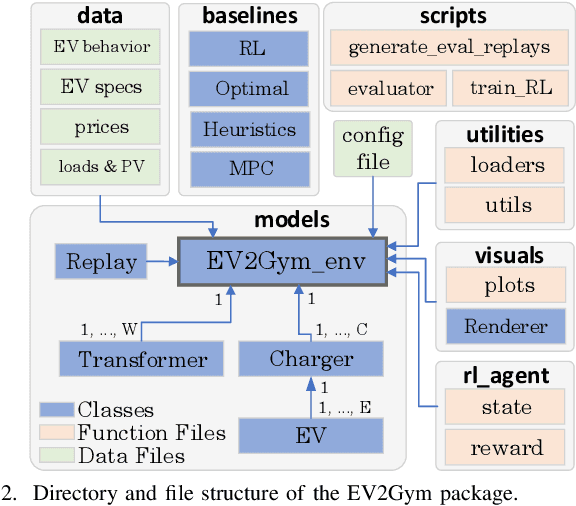

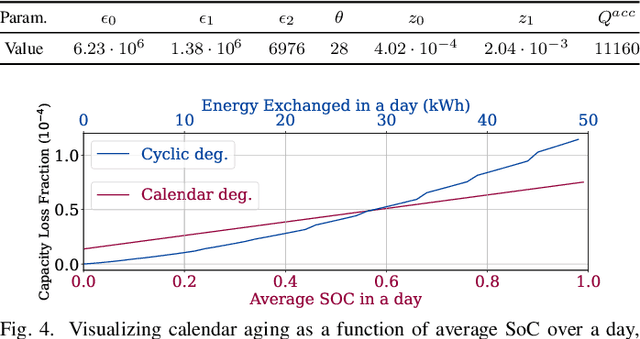
Abstract:As electric vehicle (EV) numbers rise, concerns about the capacity of current charging and power grid infrastructure grow, necessitating the development of smart charging solutions. While many smart charging simulators have been developed in recent years, only a few support the development of Reinforcement Learning (RL) algorithms in the form of a Gym environment, and those that do usually lack depth in modeling Vehicle-to-Grid (V2G) scenarios. To address the aforementioned issues, this paper introduces the EV2Gym, a realistic simulator platform for the development and assessment of small and large-scale smart charging algorithms within a standardized platform. The proposed simulator is populated with comprehensive EV, charging station, power transformer, and EV behavior models validated using real data. EV2Gym has a highly customizable interface empowering users to choose from pre-designed case studies or craft their own customized scenarios to suit their specific requirements. Moreover, it incorporates a diverse array of RL, mathematical programming, and heuristic algorithms to speed up the development and benchmarking of new solutions. By offering a unified and standardized platform, EV2Gym aims to provide researchers and practitioners with a robust environment for advancing and assessing smart charging algorithms.
PowerFlowNet: Leveraging Message Passing GNNs for Improved Power Flow Approximation
Nov 06, 2023



Abstract:Accurate and efficient power flow (PF) analysis is crucial in modern electrical networks' efficient operation and planning. Therefore, there is a need for scalable algorithms capable of handling large-scale power networks that can provide accurate and fast solutions. Graph Neural Networks (GNNs) have emerged as a promising approach for enhancing the speed of PF approximations by leveraging their ability to capture distinctive features from the underlying power network graph. In this study, we introduce PowerFlowNet, a novel GNN architecture for PF approximation that showcases similar performance with the traditional Newton-Raphson method but achieves it 4 times faster in the simple IEEE 14-bus system and 145 times faster in the realistic case of the French high voltage network (6470rte). Meanwhile, it significantly outperforms other traditional approximation methods, such as the DC relaxation method, in terms of performance and execution time; therefore, making PowerFlowNet a highly promising solution for real-world PF analysis. Furthermore, we verify the efficacy of our approach by conducting an in-depth experimental evaluation, thoroughly examining the performance, scalability, interpretability, and architectural dependability of PowerFlowNet. The evaluation provides insights into the behavior and potential applications of GNNs in power system analysis.
 Add to Chrome
Add to Chrome Add to Firefox
Add to Firefox Add to Edge
Add to Edge